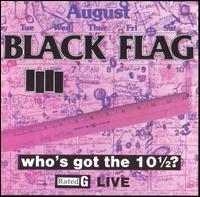Often the debate arises on whether it was Henry Rollins or Greg Ginn that ruined Black Flag. Sometimes Unicorn's 1982-1983 injunction on Black Flag releases is singled out as the culprit. Despite valid points on all sides, the fact is that all three theories blaming someone for ruining Black Flag are wrong simply because Black Flag was never ruined. While the immediate differences between the pre-Damaged and post-Damaged output are quite striking, let's remember that with every release, Black Flag evolved its sound going in dramatic new directions. What made Black Flag stand out is that it was willing to take risks that its contemporaries eschewed. Look at the entirely non-musical Dez-era song "Machine," or Rollins' version of "Damaged 1." These songs stand as some of Black Flag's greatest moments because they were risky, dangerous, and completely brand new. So, once Black Flag began to evolve past Damaged, it's unfair to accuse the band of changing or being ruined. In contrast, Black Flag seemed to be the most punk of all by refusing to identify with a certain image, sound and vehemently remaining DIY. So on the band's final release, the live Who's Got the 10½?, Black Flag matured into an infinitely interesting, sometimes meandering, improvisational unit.
Featuring the band's second to last incarnation which included Kira and Anthony Martinez, the songs on 10½ feature more fiery takes than their studio counterparts. Together, Kira and Roessler add a more metallic, heaver sound to the band. Whereas Black Flag used to snap in and out of songs in a wild frenzy, they now trudged down hills picking up momentum as the songs progressed. Some of the latter day Black Flag albums had some songs that seemed under-rehearsed, as if the band didn't know quite where to add emphasis on certain parts of certain songs. But by the time they were recorded for this album, the tunes were at that perfect point where the band is comfortable to let the songs stretch themselves out, but no so comfortable with them that they become stale. Rollins howls not just at the song's climax, but also at unexpected parts, making the music seem more freeform than any previous release. Lastly, Rollins seems to have really supplied the extra umph that was missing from the three overly rushed 1984 SST albums, particularly in "Annihilate," which as legend goes, was written in reaction to Loverboy's "Workin' for the Weekend." Ginn's response features some of his most clever lyrics with the ambiguous phrase "You just can't forget that night in your Corvette."
Greg Ginn, the mastermind behind Back Flag, seems to have forgone the idea in creating snappy tunes in lieu of creating challenging songs. On "Modern Man," "The Best One Yet" and "I'm the One" the guitar lines don't sound "good," but they challenge the ear to develop the ability to appreciate Ginn's purposeful dissonance. Sometimes the bar Ginn sets on the live recording is rewarding as it enables the listener to appreciate new levels of sonic textures (as opposed to musical textures) and sometimes he either sets the bar too high or doesn't set it at all and all we get is nasty noise.
While the earlier Black Flag albums were challenging in their brevity and conciseness, Who's Got the 10½? is challenging in its length and complexity. Sometimes it does drone on and overstay its welcome. But in the places where the sonic experiments are successful, Black Flag proves that it was one of the most successful and daring groups not only in punk, but in modern music itself.
